
Journal of the Modern
Battles Club
Published bi-monthly. Premier issue: May 2002
Editor-in-Chief: PFC
Tom Ciampa
Publisher: Trung Si Nguyen Duc Tho
From the President Gentlemen, it is my pleasure to present the premier issue of The Line of Demarcation, the journal of the Modern Battles Club. This is a joint enterprise, but the driving force behind it is PFC Tom Ciampa, C/1/503 Para USA - originator, general editor, main contributor, graphics designer ... thanks, Tom, what a great idea. I happen to be the publisher (by default, not due to any web design skills on my part, which should be all too obvious at first glance ...). The contributions come from active club members - or so we hope!
We will try to publish The Line of Demarcation on a bi-monthly base, and to have certain columns appear in each issue - depending on the input we get, of course. In the long run, the journal will only be a success if a fair number of club members contribute once in a while.
Now, Gentlemen, I hope you have fun with the premier issue.
Sincerely,
Trung
Si Nguyen Duc Tho
President, MBC
aka Dierk Walter

Contents of this issue:
Ride of the Valkyries, or Helicopter Tactics (Tactics)
Eighty-ones (Weapon Profile)
Tigerland: From Boot Camp to Tigerland then to Nam! (Film Review)
SEAL Team: Golden Oldie! (Game Review)
My Tactics (Tactics)
For the readers among us (Book Review)
During a game, Tom Ciampa asked me: "Do you think you could confide your chopper tactics to me? I know to try to get them to ground and to try to keep from hovering. But I see your rather elaborate and careful circling and how you shoot then turn around and go to the rear about 15 hexes and then turn around again and go right back where you started. I assume there is a sensible reason for doing so but I don't know why. There isn't any reason to "use up" their movement allowance in a turn is there? I would appreciate a lesson in Choppers if you are of a mind.
So here is my response. I never put helicopters on the ground unless there is a unique purpose to do so - like unloading or loading. Too many movement points are loss to landing and rising and then you are hovering, usually right in front of the enemy's weapons. I use the hovering rule in all my games, which makes "hovering" helos twice as easy to shoot down. Instead of going to ground, I use the "H" key to give me the M-60 range from the helo and usually try to end my turn with a good target for the next turn at long range to harass, disrupt or pin my opponent. But, I make sure I am out of range of most of his return fire.
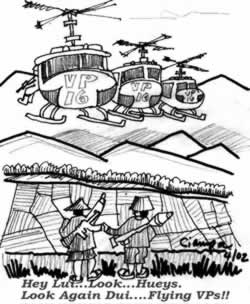 I
too have lost way too many helos to the A/I-computer in my early games.
I still lose them from time to time and they are enemy VP hexes! Once
I decide on my target, I will move toward it (if it is not in range at
the start) and take one shot and move to avoid "hovering." However,
if the target is pinned or disrupted, I will usually shoot all of my shots
remaining at it and then move directly away so that it cannot hit me until
the "hovering" indication goes off. Then I reverse course and
come back to set up the maximum range shot for the next turn. I can then
fire all 3 bursts and dance away again until hover disappears and come
back again. Remember,
the M-60 range is greater that the RPD range and a pinned or disrupted
enemy HMG at long range seems to need a "golden bee bee" to
hit. Even then, the damage usually just grounds the helo (out of sight
and with NO point loss) rather than destroying it. I am not sure if a
helo left hovering at the end of my turn stays "hovering" through
all of the opponent's turn and therefore, gives a x2 shot benefit against
the helo. That is why I always run it around until the "hover"
indication disappears.
I
too have lost way too many helos to the A/I-computer in my early games.
I still lose them from time to time and they are enemy VP hexes! Once
I decide on my target, I will move toward it (if it is not in range at
the start) and take one shot and move to avoid "hovering." However,
if the target is pinned or disrupted, I will usually shoot all of my shots
remaining at it and then move directly away so that it cannot hit me until
the "hovering" indication goes off. Then I reverse course and
come back to set up the maximum range shot for the next turn. I can then
fire all 3 bursts and dance away again until hover disappears and come
back again. Remember,
the M-60 range is greater that the RPD range and a pinned or disrupted
enemy HMG at long range seems to need a "golden bee bee" to
hit. Even then, the damage usually just grounds the helo (out of sight
and with NO point loss) rather than destroying it. I am not sure if a
helo left hovering at the end of my turn stays "hovering" through
all of the opponent's turn and therefore, gives a x2 shot benefit against
the helo. That is why I always run it around until the "hover"
indication disappears.
Remember also, that you can
only land in open or rice paddy hexes. I always check the hex visibility
from the ground before going there to land to make sure I land in a covered
position away from enemy known or suspected enemy position.
by
PFC Tom Ciampa
The 81-mm mortars (M29) were
the standard infantry mortar of the Vietnam War. Where other fire support
such as heavy artillery, air, armor, and special weapons were provided
by separate units, the Eighty-ones were operated by the infantry company
itself. The weapon could be humped in along with the company on patrol,
re-location or special missions. It broke down into four parts and weighed
in at 122 pounds. After 1967 a later model weighed less than 100 pounds.
The weapon could be fired as fast as a man could drop the shells down
the tube, for short periods of time at least, and reportedly could achieve
a rapid fire rate of thirty rounds a minute, and four to twelve rounds
sustained fire.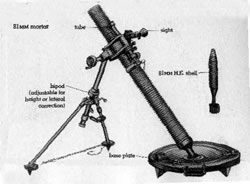 It was capable of firing HE, phosphorous, and illumination flares. Fuses
were adjustable and could be set to explode in mid-aid or upon impact.
It could elevate from 40° to 85° and traverse 4° left and
4° right. A technique employed to penetrate the often-thick canopy
of jungle growth was to set the fuse some number of milliseconds after
impact allowing the shell to continue to fall even after hitting heavy
foliage or a branch on the way down. It had a range of two to three miles,
was an "area weapon" having an approximately 60 foot radius
about the point of impact, and was generally considered a very reliable
weapon. Given this limitation of area fire, it was naturally, not a weapon
that was thought of as able to pinpoint a small target. Its principal
advantage was in its easy mobility, and its high trajectory. Usually fired
at a 45-degree angle, the rounds dropped almost vertically easily penetrating
the jungle canopy than weapons having a flatter trajectory. [Reference:
The Vietnam Experience: America Takes Over 1965-67, Boston Publishing,
1982]
It was capable of firing HE, phosphorous, and illumination flares. Fuses
were adjustable and could be set to explode in mid-aid or upon impact.
It could elevate from 40° to 85° and traverse 4° left and
4° right. A technique employed to penetrate the often-thick canopy
of jungle growth was to set the fuse some number of milliseconds after
impact allowing the shell to continue to fall even after hitting heavy
foliage or a branch on the way down. It had a range of two to three miles,
was an "area weapon" having an approximately 60 foot radius
about the point of impact, and was generally considered a very reliable
weapon. Given this limitation of area fire, it was naturally, not a weapon
that was thought of as able to pinpoint a small target. Its principal
advantage was in its easy mobility, and its high trajectory. Usually fired
at a 45-degree angle, the rounds dropped almost vertically easily penetrating
the jungle canopy than weapons having a flatter trajectory. [Reference:
The Vietnam Experience: America Takes Over 1965-67, Boston Publishing,
1982]
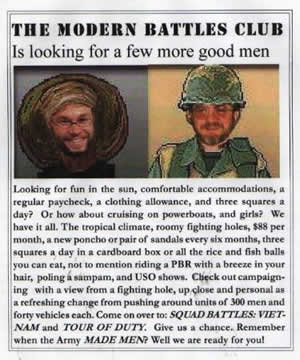
Tigerland
From Boot Camp to Tigerland then to Nam!
by Lance Cpl. Glyn Hargreaves
Certificate: 18/R
Running time: 101 mins.
Director: Joel Schumacher
Starring: Collin Farrell, Matthew Davis, Clifton Collins Jr. and
Shea Whigham.
Year Made: 2000
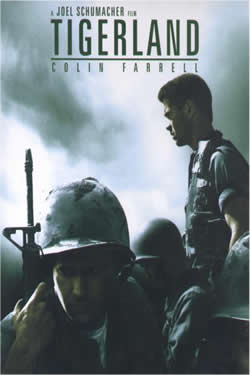 You
may think 'oh, no not him! The hairdresser-come-director.' Making a movie
about draftees training before Vietnam…Yeah okay he did ruin the
Batman movies (Batman and Robin anyone?) and was to blame for St. Elmo's
Fire but listen up this film is good!!
You
may think 'oh, no not him! The hairdresser-come-director.' Making a movie
about draftees training before Vietnam…Yeah okay he did ruin the
Batman movies (Batman and Robin anyone?) and was to blame for St. Elmo's
Fire but listen up this film is good!!
The film is set in 1971, about the tough training camp Tigerland at Fort Polk Louisiana where thousands of recruits have to undergo Vietnam jungle like conditions before being shipped off to Vietnam. It centres on the lead characters Bozz played by Farrell who is waging a war against the system. Paxton, played by Davis, sees war as his duty but it will be the inspiration for his writing.
Bozz is the man with the natural talent to be a leader of men but is determined to rebel all the way through the hell of boot camp. With all the weight of the NCOs on his back and some of his fellow recruits who don't want to rock the system (one great performance by Shea Whigham as the up tight Wilson), Bozz with his knowledge of military law uses it to drive the war machine spare.
The drill sergeants think he is a coward gone communist, and to break him they need to use force. As it turns out, however, Bozz is the man you would trust with your life, and turning the tables, he is made the platoon leader giving hope to most of his fellow draftees.
The film has a few minor flaws. Some of the black characters don't really get much of a look in and are presented just as stereotypes (including the sadistic NCO who is really a coward at heart). The training segment in Tigerland isn't long enough being only about the last 20 minutes of the movie. Given that though this is a film not to be missed.
The film's theme has been seen before in many other guises (Full Metal Jacket, Biloxi Blues to name a couple) but not like this. Schumacher shot this on digital video using handheld cameras in order to give the film a grainy, documentary style all its own presenting greater impact and immersing you in its brutal world with the ever-present war in the background. The shooting style is a change from Schumacher's normal style over content in his movies. The strength of the screenplay, based on one of the writer's true experiences in the army, is a real gem.
Colin Farrell is a star in the making and you wouldn't think that he was from Dublin not from Texas, though his accent sometimes slips out when he swears. He gives, however, an otherwise really outstanding and sublime performance. He will soon be seen staring alongside Mr. Tom Cruise in Minority Report. Farrell has come along way since Ballykissangel!
Don't go watching this expecting Full Metal Jacket (no Charlie's are in sight), but watch to get a better view on the complex and subtle change between relationships of men on their way to war.
8/10
Out now to rent or buy DVD/Video
US
Army 173D 1st Squad
- NEWS -
by PFC Tom Ciampa
Squad member, Pvt. Tom
Konczal has amassed an impressive 48.8 points in less than the three
months of his membership in the club and the squad, earning seven medals
as well as the relatively rare Recruiter's Badge. Tom plays a prodigious
number of games, both against the enemy and as maneuvers with his US Forces
comrades. He generously shares his insights on game play and tactics and
has completed a small fictional SB:V battle he calls SB:V Night Patrol
as described below. See also his recent entry on the subject at the Saigon
Country Club.
SBV Night Patrol (Tom Konczal)
June 29, 1967 - Fictional - Platoon Level. US: First squad is on ambush.
The rest of the platoon is to join up with them and search the village
to the southwest. You only have 1 hour and 15 minutes to complete this
patrol (15 turns). VC: Protect the village while exiting the second unit
from the board. It is available at http://members.aol.com/tomk1
It has complete
scripts and should be playable solo from either side. Tom would appreciate
people playing it and emailing him their comments and suggestions.
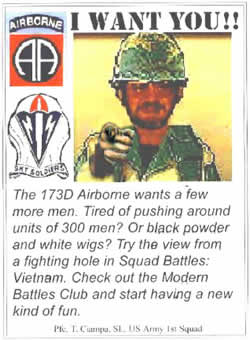 Tom
has also made available at the same location (noted above) a complete
listing in both Quattro Pro and Excel of all the scenarios from both SB:V
and ToD. These include the game disk scenarios and add-ons from the Internet
in order of date in case you want to play the entire war! If you know
of any scenarios that are not on Tom K's list, please email him with a
copy.
Tom
has also made available at the same location (noted above) a complete
listing in both Quattro Pro and Excel of all the scenarios from both SB:V
and ToD. These include the game disk scenarios and add-ons from the Internet
in order of date in case you want to play the entire war! If you know
of any scenarios that are not on Tom K's list, please email him with a
copy.
Pvt. John Collins has
generously assumed responsibility for creating and maintaining the US
Army's 173D Airborne page of decorations and awards ("medals page)
at the expense of no little midnight oil and a lot of frustration learning
FrontPage and other tricks. I think he mentioned something about his sister
helping! Now that is what one would call real close (combat) family support!
The 173D thanks John for his volunteerism. You can check out the 173D's
individual awards by going here: http://home.earthlink.net/~jwccccbb/index.html
Pvt. Daniel Bottemanne
has come out of the Reserves and joined in the 173D's campaign to
re-establish democracy. And active he is. Thanks Daniel.
Pvt. Kenny O'Leary toyed with going into Reserve status but fortunately
for us he changed his mind, has found some time, and is likewise back
in support of the squad. Thanks Kenny.
PFC Mike Bozyk suffered through a half a dozen or so replacement
cable modems from his provider, Comcast, but despite that ordeal, managed
to keep our page up, running and updated. Thanks to The Boz for this particularly
frustrating month and all his past toil on behalf of the Squad.
Pvt. Tony Best has entered the reserves. We will miss your participation
Tony, but we are hopeful you will be back once you get your current busy
schedule behind you. Thanks for not abandoning us.
Members Hamilton, Keys, Reuter, and Pritchard continue to be active
making ours, a highly respectable and active squad in the club. Thanks
fellows.
PFC Tom Ciampa, and your not-so-intrepid squad leader, has earned
the dubious honor of being awarded the only Purple Heart on the board,
and probably in any club on the Net! (Publisher's note:
I am the proud recipient of one the few Purple Hearts awarded by our sister
club, the ACWGC!) I continue to try to win a game but am nevertheless
having (some) fun losing. Working on this Newsletter project has been
very enjoyable. It is a great deal of work, and of course a big thanks
goes out to those who have contributed already. I here appeal to others
to contribute if they are of a mind. Thank you.
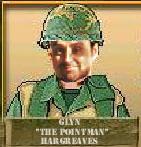 And
finally…The Keeper of the Points …for those who don't
know, it is fitting that this squad extend a special appreciation to a
club member who is not a 1st Squad member, but who toils constantly on
our behalf. LCpl. Glyn Hargreaves, of the Australian 6RAR cheerfully takes
on the monthly task to receive and keep track of all of our games, posting
and reporting the points so earned month after month after month. He works
well beyond the value of the few points of compensation so tendered. Glyn
is most definitely one of the unsung heroes who quietly go about his work
behind the scenes to keep the club running.
And
finally…The Keeper of the Points …for those who don't
know, it is fitting that this squad extend a special appreciation to a
club member who is not a 1st Squad member, but who toils constantly on
our behalf. LCpl. Glyn Hargreaves, of the Australian 6RAR cheerfully takes
on the monthly task to receive and keep track of all of our games, posting
and reporting the points so earned month after month after month. He works
well beyond the value of the few points of compensation so tendered. Glyn
is most definitely one of the unsung heroes who quietly go about his work
behind the scenes to keep the club running.
by Trung Si Nguyen Duc Tho
During the last months, Binh Nhi's David Stotsenburgh (on 03/20) and Diego Laiseka (on 05/07) have joined our struggle for national liberation and freedom from Coca-Cola. Within the few weeks he is with us, Binh Nhi David has already proven that he will be an invaluable asset for our fight, and of course we expect much the same from Binh Nhi Diego.
Binh Nhat Sam Moon continues to be the mainstay of the squad, inconspicuous, but utterly reliable and always out there whipping Imperialists. His combat record is simply impressive and he has recently earned the Training Service Medal 1st Class, for five completed maneuver games, and is just two games short of the People's Army Silver Star, for 25 games all in all.
Having recently come out of retirement, Binh Nhi Mark Biss has picked up quite a number of fights and is on the best way to earn an impressive record himself.
The current battle record for the entire squad (since the inception of the club) is an astonishing 45 victories, as compared to 27 defeats and 25 draws.
Forward, for Uncle Ho!
by
PFC Tom Ciampa
Electronic
Arts, 1993, 1995
Original Specs: 386DX33+, 4MB, 586K, DOS 5.0+, VGA, Mouse, Joy
or Keyboard, AdLib and SoundBlaster but note well: Runs under WIN95/98
system!!
Whether you call it a Golden Oldie or an Oldie but Goodie, SEAL TEAM by Electronic Arts, 1993 (re-issued as a classic on CD Rom in 1995), is still a cool game of squad (man to man) combat during the Vietnam era from early 1966 to late in 1969. Seal Team's graphics are certainly dated and by no means as slick as the 3D graphics of today as seen in games like those of the Spec Ops series, but this game is never-the-less a playable, fun and very interesting game. An early attempt at a first person 3D engine, its squad members are a little on the flat side and the images of the jungle foliage and VC are less detailed than today's, but the game works, is challenging and fun. It combines the feel of role-playing via its campaign mode with a challenging multi-format mission scheme and the detail of many different weapon selections. Besides the expected ARs and other rifles, pistol, and knife, you can throw grenades (always fun) or my favorite, using the thumpgun. You walk, crawl, run, stop, search, pick-up etc. as in any action game, and the team is inserted into the bush and picked up by PBR or Chopper. The sounds are great.
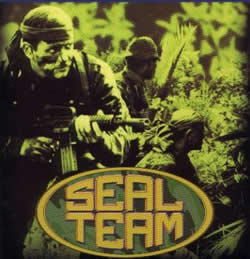 Seal
Team is most definitely the ancestor of Commandos without the benefit
of today's processors. The 92 page game manual containing a wealth of
Vietnam history and squad weapons and specs, is alone worth the few dollars
this game costs in discount bins, overstocks, fleamarkets, garage sales,
and even on eBay. A printed manual came in the original boxed 3 ½"
floppy version. The CD version has the manual in PDF format for Acrobat.
Finding it these days, however, is a problem, but you can get lucky if
you keep your eyes peeled.
Seal
Team is most definitely the ancestor of Commandos without the benefit
of today's processors. The 92 page game manual containing a wealth of
Vietnam history and squad weapons and specs, is alone worth the few dollars
this game costs in discount bins, overstocks, fleamarkets, garage sales,
and even on eBay. A printed manual came in the original boxed 3 ½"
floppy version. The CD version has the manual in PDF format for Acrobat.
Finding it these days, however, is a problem, but you can get lucky if
you keep your eyes peeled.
The really remarkable thing about this game, and indeed many of Electronic Arts Offerings, is that although they were programmed for DOS they run under the Win95/98 system right out of the box with no special high tech tweaking! (I can run it flawlessly on a PII 233 with a SoundBlaster card).Put the CD or 3 ½" floppy set in the drive, hit run and bingo! The game installs in a minute. Hit the st.exe file and you are presented with a great soundtrack of oriental backdrop music and a menu of "Practice Missions" and a "Campaign" mode.
You can select missions from among patrol, ambush, demolition, observe, or rescue. The campaign randomizes them all. Use the keyboard, the mouse, a joystick, or all three. You view and operate your 4-man team or squad in 3D mode from any angle and can watch the action from their perspective or from the enemy's. Each scenario begins with an Intel Briefing on a map and a patrol and marching order indicating objectives and the composition of the team: their names, weapons, and skills. You are first inserted by PBR or Chopper and extracted whenever you feel the mission is completed or you judge that cutting bait and aborting is more practical than continuing.
Seal Team is more a first person adventure game than the tactical tour de force such as John Tiller's Squad Battles series. But it is a hell of a lot of fun, and for a few bucks, certainly is a curiosity that will amuse you long enough to at least get your couple of dollar's worth.
The Line of Demarcation is the Journal of the Modern Battles Club, a member of the International Wargame Club. ©Dierk Walter 2002. Please address contributions to the editor-in-chief, Thomas D. Ciampa.
by Pvt. Tom Konczal
On the attack, most games start as a draw or the enemy victory as the attacking US player. Therefore, I see how many points I need first, to draw, and then to get a minor victory. I never try to get a major victory at the start of the scenario. I try to minimize the VP hexes necessary to accomplish first the draw, then the minor victory. I concentrate all of my assets that can reach those hexes in time against that one or two VP hex(es). Do not get fixated by a company action where three platoons face three VP hexes. Maneuver and attack only one IF that one will give you the draw or victory. after it is taken and the draw is assured, then see what else you can do to increase the victory levels..
On the defense, I care more about pinning or disrupting an enemy unit. Once that is done, shoot at another unit to pin or disrupt it. If he cannot move or move only one hex and lose fire that turn, you can slow or halt his attack. He usually doesn't have enough leaders to clear pins and disruptions. As the game nears the end, withdraw to keep a hex or two between you and the attacker as long as he cannot make the VP hex in a turn or two. The game is not reality, you can win by being totally surrounded sitting on your VP hex as the game ends because there is no next turn! Play your end game on defense. US players should always lead in the enemy killed or exchange ratio, especially if he has off board artillery or air support.
Now, back to the war and on to Victory!
by PFC Tom Ciampa
Seen in Barnes & Noble
recently, a re-publication of Keith William Noland's wonderfully detailed
and interesting account: The Battle for Hue - Tet 1968. First published
in 1983 by Presidio Press, it was put out again in paperback in 1996 by
Presidio in a handsome format. A great read and really puts the current
Battle for Hue City Tournament into perspective. 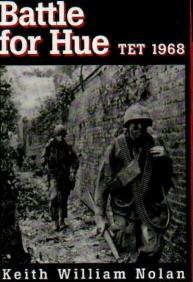 What
is remarkable is the fact that Mr. Nolan, now a recognized scholar of
the War, wrote the book when he was nineteen years old. Do the math: he
states that he was 3 years old at the time of the battle and the original
edition was published in 1983. To quote the cover of the book: "Nolan
dismissed the negative stories and disparaging charges made against Vietnam
veterans in general - drugs, desertion, unnecessary and wholesale slaughter
- and set about interviewing veterans of the fighting at Hue, studying
the available literature and researching the archives in order to present
an accurate picture of what the American grunt went through in Vietnam."
Original copies are hard to find or pricey. For those who collect and
have a personal library, check out your local bookstores as you may get
lucky and find one of the later paperback editions. There is always the
Internet for both the original and the later release, and of course, the
public library should be a reliable source as well. The message is, however,
if you only read a couple of books on the war, you might consider this
one. It is excellent. [Battle for Hue: Tet 1968,
Presidio Press, 1983 hardcover, 1996 paper, 201 pages, center section
of twenty black and white photographs]
What
is remarkable is the fact that Mr. Nolan, now a recognized scholar of
the War, wrote the book when he was nineteen years old. Do the math: he
states that he was 3 years old at the time of the battle and the original
edition was published in 1983. To quote the cover of the book: "Nolan
dismissed the negative stories and disparaging charges made against Vietnam
veterans in general - drugs, desertion, unnecessary and wholesale slaughter
- and set about interviewing veterans of the fighting at Hue, studying
the available literature and researching the archives in order to present
an accurate picture of what the American grunt went through in Vietnam."
Original copies are hard to find or pricey. For those who collect and
have a personal library, check out your local bookstores as you may get
lucky and find one of the later paperback editions. There is always the
Internet for both the original and the later release, and of course, the
public library should be a reliable source as well. The message is, however,
if you only read a couple of books on the war, you might consider this
one. It is excellent. [Battle for Hue: Tet 1968,
Presidio Press, 1983 hardcover, 1996 paper, 201 pages, center section
of twenty black and white photographs]